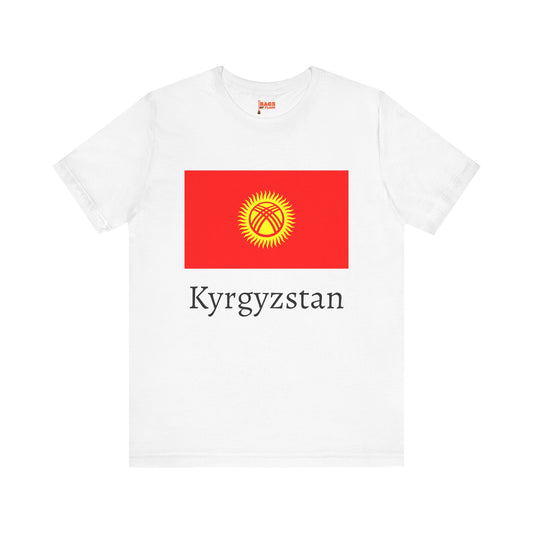-
Kyrgyzstan Inspired Sweatshirt
Regular price $34.15 USDRegular priceUnit price / per -
Kyrgyzstan Sweatshirt
Regular price $34.15 USDRegular priceUnit price / per -
Kyrgyzstan Flag Sweatshirt
Regular price $34.15 USDRegular priceUnit price / per -
Kyrgyzstan Pillow
Regular price $22.65 USDRegular priceUnit price / per -
Kyrgyzstan Backpack
Regular price $59.79 USDRegular priceUnit price / per -
Kyrgyzstan Leather Patch Hat
Regular price $18.85 USDRegular priceUnit price / per -
Kyrgyzstan Mug
Regular price $11.65 USDRegular priceUnit price / per -
Kyrgyzstan Trucker Cap
Regular price $14.90 USDRegular priceUnit price / per -
Kyrgyzstan Inspired Hoodie
Regular price $34.40 USDRegular priceUnit price / per -
Kyrgyzstan Hoodies
Regular price $34.40 USDRegular priceUnit price / per -
Kyrgyzstan T-shirts
Regular price $22.79 USDRegular priceUnit price / per -
Kyrgyzstan Flag on Hoodie
Regular price $34.40 USDRegular priceUnit price / per -
Kyrgyzstan Inspired T-shirt
Regular price $22.79 USDRegular priceUnit price / per -
Kyrgyzstan Flag on T-shirt
Regular price $22.79 USDRegular priceUnit price / per
Collection: Kyrgyzstan
The Kyrgyzstan flag symbolizes national pride and identity, with a rich history and deep symbolism. We will explore the design, historical context, symbolism, current relevance, and additional facts about the flag of Kyrgyzstan.
Overview of the Kyrgyzstan Flag

At the heart of Kyrgyzstan's national identity lies its flag, featuring a vibrant red background decorated with a golden sun at the center, encircled by forty evenly spaced rays. Two sets of three curved lines intersect directly beneath the sun, mimicking the traditional Kyrgyz yurt's tündük or roof crown. This design intricately weaves together elements of the nation's past and aspirations for its future. The choice of red for the flag's background speaks to the courage and sacrifices made to pursue freedom, while the golden sun represents the country's hope and the prosperity ahead.
The sun's forty rays hold a special significance, symbolizing the unity of the forty tribes that legend says were united by the epic hero Manas to form the nation. The depiction of the yurt, a cornerstone of Kyrgyz nomadic culture, emphasizes the importance of heritage and the enduring connection to the country's nomadic roots. This flag serves as a national emblem and a reminder of Kyrgyzstan's journey toward independence and its ongoing quest for identity and unity in the modern world.
Historical Context of the Flag
The current flag of Kyrgyzstan, a symbol of independence and national identity, was officially adopted on March 3, 1992, in the aftermath of the dissolution of the Soviet Union. The adoption of this flag signified a pivotal moment for Kyrgyzstan, marking its emergence as a sovereign state after decades of Soviet influence. The design deviates significantly from the symbols of the Soviet era, incorporating elements that are deeply rooted in Kyrgyz culture and history. This transition from the flag of the Kirghiz Soviet Socialist Republic to the current flag underscored the nation's desire to reclaim its cultural heritage and forge a distinct national identity. Adopting the flag was part of broader efforts to establish symbols that reflect the values and aspirations of the Kyrgyz people in their newly independent country. Adopting a flag with such meaningful symbols was a deliberate move to unify the nation and symbolize a new chapter in Kyrgyzstan's history, away from its past under Soviet rule.
Symbolism Behind the Flag

The symbolic elements of the Kyrgyzstan flag are deeply interwoven with the nation's ethos and aspirations. The predominant red backdrop of the flag is a nod to the bravery and courage of the Kyrgyz people, a testament to their enduring spirit in the face of challenges. Centered within this field of courage lies a golden sun, a beacon of hope and prosperity for Kyrgyzstan's future. This luminary, with its forty radiant beams, signifies the legendary unification of the forty tribes under the epic hero Manas. This event stands as a cornerstone of Kyrgyz's national identity.
Beneath the sun, the depiction of the crossed curved lines takes inspiration from the tündük, the architectural pinnacle of the Kyrgyz yurt. This detail is not merely ornamental but serves as a tribute to the traditional nomadic lifestyle of the Kyrgyz people, reflecting their deep connection to nature and their heritage. Each element of the flag's design has been meticulously chosen to convey Kyrgyzstan's values, history, and culture. It is a constant reminder of the nation's journey from its nomadic roots to its present state and its unwavering pursuit of unity and progress.
Current Relevance of the Flag
Today, the Kyrgyzstan flag stands as a vibrant beacon of the nation's sovereignty, prominently showcased during significant state ceremonies, military commemorations, and various national festivities. Its presence reinforces the collective identity and unity among the citizens, symbolizing not just the country's rich history but also its aspirations and achievements as an independent nation. The flag's usage extends beyond formal state functions; it is also a familiar sight at international sports competitions and diplomatic events, where it represents Kyrgyzstan on the global stage, fostering a sense of national pride among the Kyrgyz people worldwide.
Despite its widespread acceptance and reverence, the flag has occasionally sparked discussions regarding its design and the depth of its symbolism. These debates reflect the dynamic nature of national identity and the diverse perspectives within Kyrgyz society. Nonetheless, these discussions have not detracted from the flag's status as a cherished emblem of the nation. Instead, they underscore the importance of the flag as a living symbol that engages the public and evolves with the nation. As such, the Kyrgyzstan flag continues to be an essential part of the country's fabric, embodying the spirit and values of the Kyrgyz people, and playing a crucial role in national celebrations and moments of reflection.
Additional Facts About the Kyrgyzstan Flag
Ensuring the flag's respectful presentation is paramount; it must always be hoisted and taken down ceremoniously. The flag is to be kept pristine, never allowed to desecrate the earth by resting upon it or being employed in any manner that could be considered disrespectful. Within the Kyrgyz cultural context, the flag transcends mere symbolism to embody the sacred essence of the nation, meriting a level of veneration reflective of its significance.
Additionally, protocols dictate that the flag should occupy a position of prominence when displayed alongside other flags, signifying its sovereignty and the esteem in which it is held. During times of national mourning, the flag is lowered to half-staff, a gesture of collective grief and respect for the deceased.
An interesting protocol concerning the flag involves its depiction in various forms of media and public representations. Care must be taken to ensure the accuracy of its colors and symbols, preserving the integrity and intended symbolism of the design. Misrepresentation or alteration of the flag is considered a serious affront, highlighting the deep respect and connection the Kyrgyz people have for their national emblem.
The flag’s presence extends beyond the borders of Kyrgyzstan, serving as a symbol of unity and pride for the diaspora, reinforcing their connection to their homeland even from afar. This deep bond underscores the flag's role not just as a national symbol but as a beacon of identity for Kyrgyz people worldwide.




























